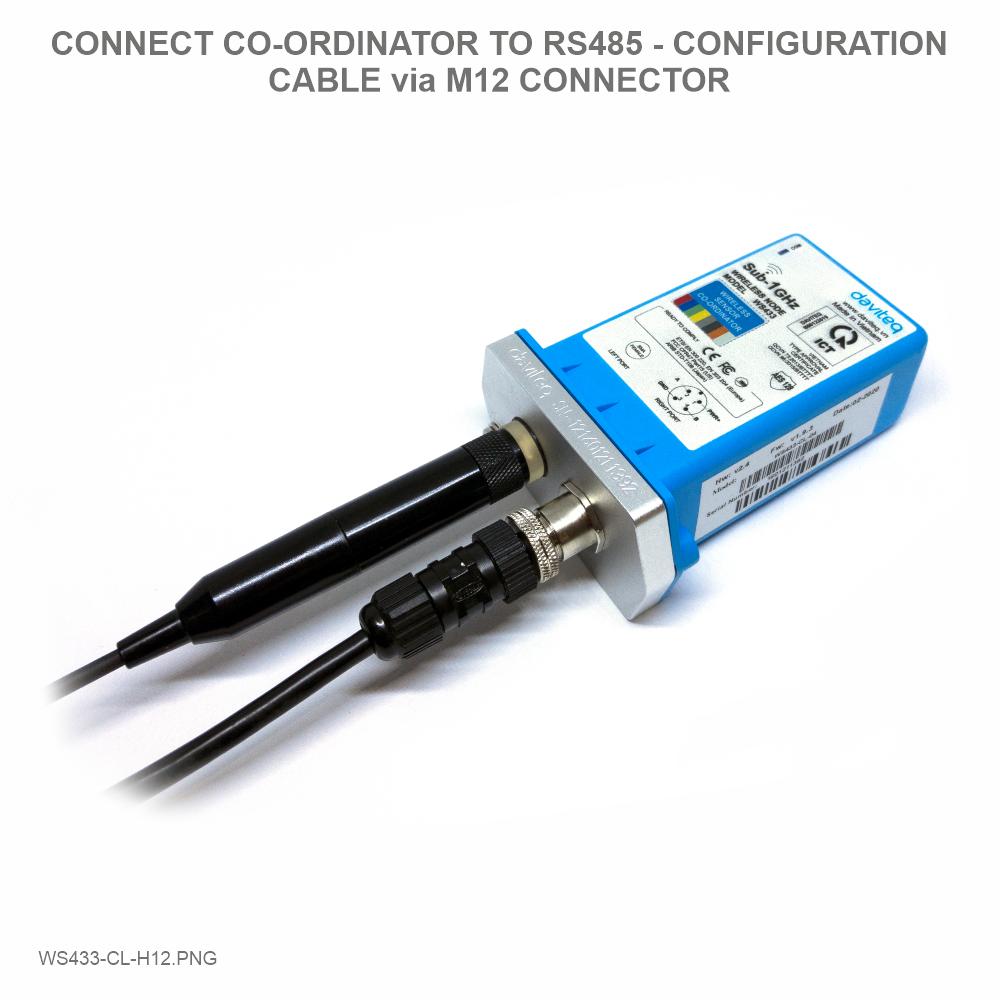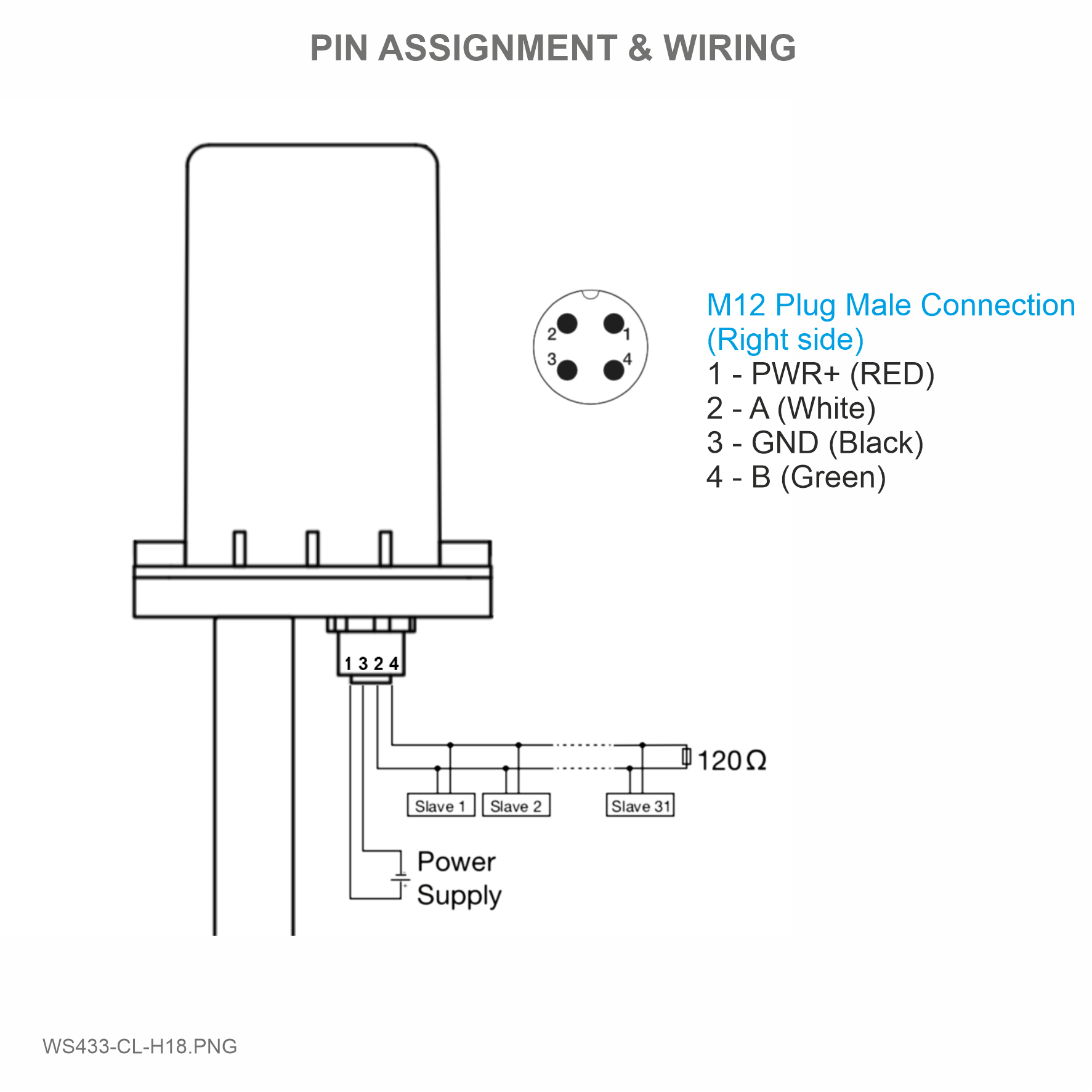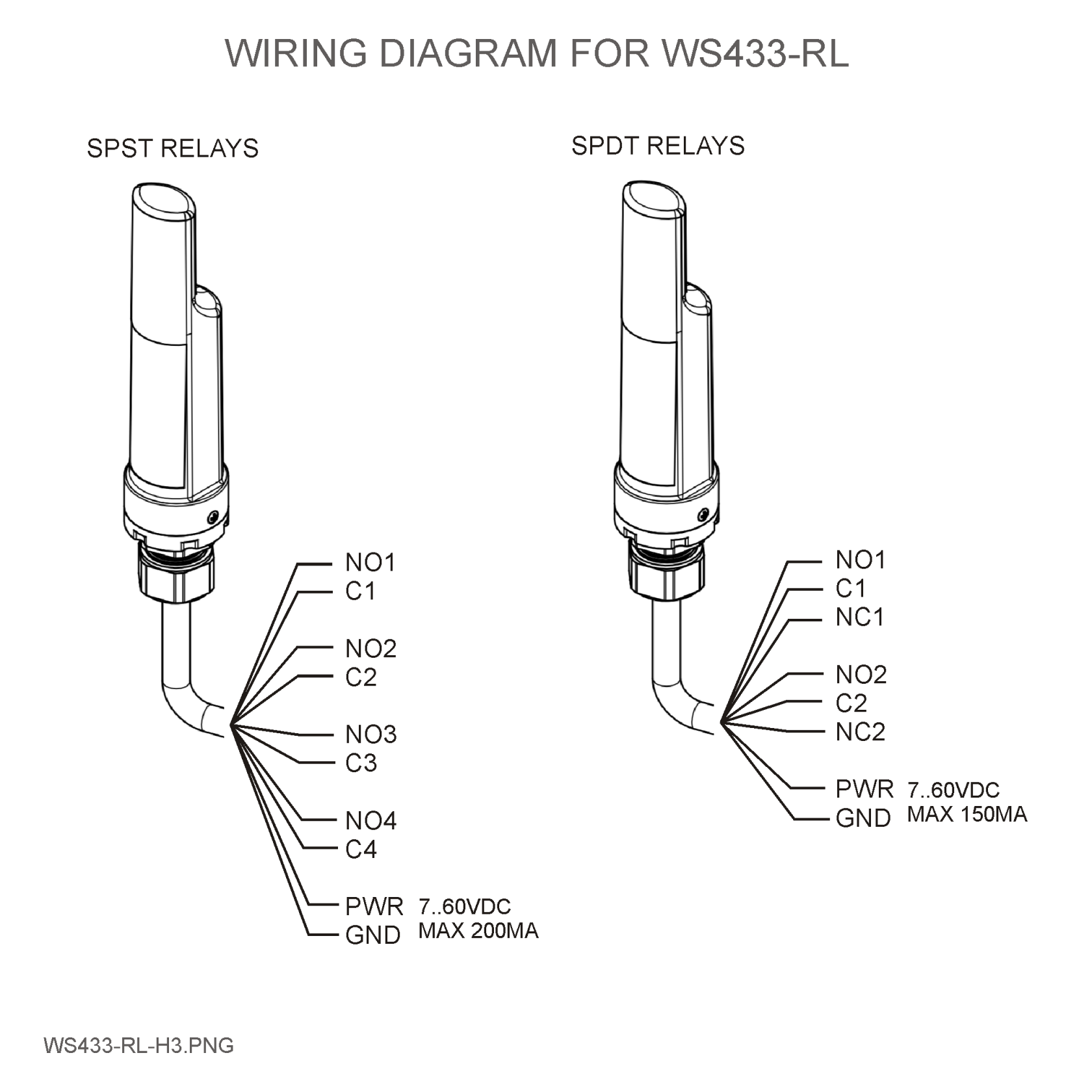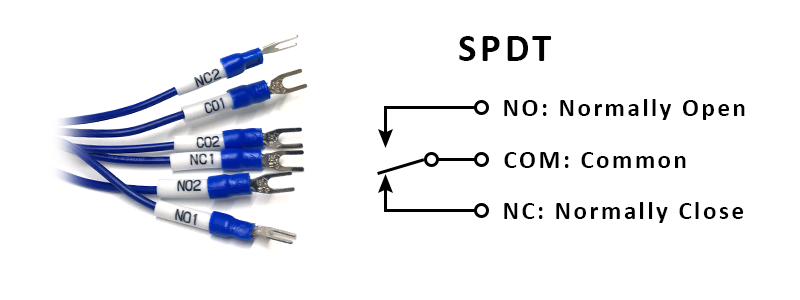USER GUIDE FOR WIRELESS RELAYS WS433-RL
| WS433-RL-MN-EN-01 |
DEC-2020 |
This document is applied for the following products
|
SKU |
WS433-RL |
HW Ver. |
2.5 |
FW Ver. |
5.0 |
|
Item Code
|
WS433-RL-14 | Wireless relay module with 04 x SPST relay, contact rating 0.5A@125VAC/1.0A@30VDC, IP67, power supply 7-60VDC, cable 05m length with PG9 cable gland | |||
| WS433-RL-12 | Wireless relay module with 02 x SPDT relay, contact rating 5.0A@250VAC, IP67, power supply 7-60VDC, cable 05m length with PG9 cable gland | ||||
1. Functions Change Log
| HW Ver. | FW Ver. | Release Date | Functions Change |
| 2.5 | 5.0 | DEC-2019 |
|
2. Introduction
Wireless Relay output module, select SPDT or SPST contacts, select 2 or 4 channels, to control your motor, pump, valve, door, alarm, lighting, machines…It is configured the operation parameters like data sending interval, health check cycle...remotely from Globiots platform or via ModbusRTU software.
3. Specification
| Outputs | 02 x SPDT relay or 04 x SPST relay |
| SPST contacts | 0.3A@125VAC/1.0A@24VDC |
| SPDT contacts | 5.0A@250VAC |
| Functions | ON/OFF |
| Electrical connection | cable 0.5m length with PG9 cable gland |
| Optional accessories | 304SS Adapter PG9/male 1/2"NPT or PG13.5 or M20 to allow direct mounting on Process instruments or electrical panel |
| Data speed | Up to 50kbps |
| Tranmission distance, LOS | 500m |
| Antenna | Internal Antenna, 3 dbi |
| Power | 7-60VDC, max 200mA |
| Frequency Band | ISM 433Mhz, Sub-GHz technology from Texas Instrument, USA |
| Receiving Sensitivity | -110dBm at 50kbps |
| International Compliance | ETSI EN 300 220, EN 303 204 (Europe) FCC CFR47 Part15 (US), ARIB STD-T108 (Japan) |
| Security Standard | AES-128 |
| Operating temperature of PCB | -40oC..+60oC (with AA L91 Energizer) |
| Housing | Poly-carbonate, IP67 |
| Installation method | L-type bracket SUS304 , by M4 screws or double-sided 3M tape (included) |
| Product dimensions | 125x30x30mm |
| Net weight (without battery) | < 100g |
| Box dimension | 190x50x50mm |
| Gross weight | 140g |
4. Typical Applications
5. Operation of wireless sensor
5.1 Add sensors node to Co-ordinator WS433-CL
5.2.1 Add Sensor Node ID automatically
 |
 |
Step 1: After supplying power the Co-ordinator via M12 connector, the Node ID must be registered within the first 5 minutes, up to 40 WS.
Step 2: Bring the wireless sensor closer to the Co-ordinator's antenna then take off the wireless sensor battery, wait for 5s then insert the battery again. If:
- Buzzer plays 1 peep sound, LED blink 1 time, that means registering Node ID on Co-ordinator successfully.
- Buzzer plays 2 peep sounds, LED blink 2 times, that this Node ID is already registered.
If you do not hear the "Peep" sound, please disconnect the power the co-ordinator, wait a few minute and try again.
Node id added in this way will be written to the smallest node_id_n address which is = 0.
Set Rssi_threshold (see RF MODE CONFIG (in the Modbus Memmap of WS433-CL), default -25): The case if Co-ordinator is on high position and need to add node sensor. We set the sensor as close as possible and set the Rssi_threshold to -80, -90 or -100 to increase the sensitivity to allow WS433-CL-04 can add sensors at a longer distance. After that, perform 2 steps of adding sensors and then reset Rssi_threshold = -25.
Enb_auto_add_sensors configuration (see RF MODE CONFIG (in the Modbus Memmap of WS433-CL)): In case you do not want to turn off the power WS433-CL, you can set Enb_auto_add_sensors = 1, this way we have 5 minutes to add nodes (add up to 40 nodes) . After 5 minutes Enb_auto_add_sensors will automatically = 0.
Memmap resgisters
You can download Modbus Memmap of WS433-CL with the following link:
https://filerun.daviteq.com/wl/?id=WBbGm89AToHWyvIyMOc780N1KmjfUr3Y
5.2.2 Add sensor node into WS433-CL-04 (1) through intermediate WS433-CL-04 (2) and Modbus
In case the sensor need to be added to WS433-CL-04 (1) has been installed in a high position, the sensor cannot be brought close to WS433-CL-04 (1). For more details:
5.2 Button Function
Open the cover of sensor then use the push button to set the data transfer speed for the first 30 seconds when the battery is first installed, after 30 seconds the push button function does not work.
- Press and hold the button for 2 seconds => LED blinks once => Release the button to set Data rate RF 50kbps
- Press and hold the button for 5 seconds => LED blinks twice => Release the button to set Data rate RF 625bps
- Press and hold the button for 10 seconds => LED blinks 3 times => Release the button to reset RF parameters (frequency, RF output power, data rate), if held for more than 30 seconds then the button function does not work.
Reset default WS433:
Frequency: 433.92 MHz
RF transmit power: 15 dBm
RF data rate: 50 kbps
5.3 Configuration
Memmap resgisters
You can download Modbus Memmap of WS433-RL with the following link:
https://filerun.daviteq.com/wl/?id=BKEaUzdArkoc0Hc7nfpRShdPVToVrqQZ
In the memmap file, refer to the Memmap of WS433-RL sheet to configure the sensor's operating parameters accordingly.
The reference memmap addresses are based on the order of the sensors added in the Memmap file above
Below are examples of some typical sensor parameters:
|
Function Code (Read) |
Function Code (Write) |
# of register |
Byte Size |
Description |
Value Range |
Default |
Format |
Property |
Explanation |
|
3 |
16 |
1 |
2 |
Control Relay 1 of sensor Node |
0-1 |
0 |
uint16 |
Read/Write |
0: turn off relay 1 |
|
3 |
16 |
1 |
2 |
Control Relay 2 of sensor Node |
0-1 |
0 |
uint16 |
Read/Write |
0: turn off relay 2 |
|
3 |
16 |
1 |
2 |
Control Relay 3 of sensor Node |
0-1 |
0 |
uint16 |
Read/Write |
0: turn off relay 3 |
|
3 |
16 |
1 |
2 |
Control Relay 4 of sensor Node |
0-1 |
0 |
uint16 |
Read/Write |
0: turn off relay 4 |
|
4 |
1 |
2 |
%Battery of sensor Node |
10,30,60,99 |
uint16 |
Read |
Battery level, only 04 levels: 10%, 30%, 60% and 99% (full). When 10% ==> Need to replace the battery |
||
|
4 |
2 |
4 |
Analog value 1 of sensor Node (parameter 1) |
float |
Read |
Value from Analog input sensor. This value is parameter 1 of a wireless sensor node |
|||
|
4 |
2 |
4 |
Value of parameter 2 of sensor Node |
float |
Read |
Same value as parameter 1 |
|||
|
3 |
1 |
2 |
Data status of Node |
0-9, 99 |
byte |
Read |
0-9: Interval updated data 99: Disconnected |
||
|
3 |
1 |
2 |
RF Signal strength of Node |
0-4 |
byte |
Read |
From 0 to 4 with 0 is being lost connection RF and 4 is the strongest RF |
||
|
3 |
16 |
1 |
2 |
Cycle_wakeup |
1-3600(s) |
120 |
uint16 |
Read/Write |
Every time interval of Cycle_wakeup, sensor node would ONLY send data to co-ordinator if the new measured value was changed more than the Delta value of the last measured value. Default Cycle_wakeup is 120 seconds |
|
3 |
16 |
1 |
2 |
Cycle_healthsta |
60-7200(s) |
600 |
uint16 |
Read/Write |
Every time interval of Cycle_healthsta, sensor node will absolutely send data to co-ordinator regardless any condition |
|
3 |
16 |
2 |
4 |
Radio frequency |
433.05-434.79, 433 Mhz |
433.92 |
float |
Read/Write |
Configure the operating frequency of wireless sensor by Co-ordinator, should be configured from 433.05-434.79 MHz, only for advanced users |
6. Installation
6.1 Installation location
Wireless sensor utilize the ultra-low power 433Mhz RF signal to transmit/receive data with Wireless co-ordinator.
To maximize the distance of transmission, the ideal condition is Line-of-sight (LOS) between the Wireless sensor and Gateway. In real life, there may be no LOS condition. However, the two modules still communicate each other, but the distance will be reduced significantly.
The bracket will be fixed on the wall or material with a flat surface with double-sided 3M tape (included in the accessory bag in a carton box) or 2 x M4 screws (supplied by the customer);
When using 3M double sided tape, please install the sensor at a height of 2 meters or less.
ATTENTION:
DO NOT install the Wireless sensor or its antenna inside a completed metallic box or housing, because the RF signal can not pass through the metallic wall. The housing is made from Non-metallic materials like plastic, glass, wood, leather, concrete, cement…is acceptable.
 |
 |
6.3 Wiring
6.3.1 Power supply connection
- Red: Power Supply
- Black: Ground (GND)
Recommend to use 24VDC power.
The signal cable from the wireless relay should be protected by corrugated hose or the plastic tube, keep the cable avoid high temperature areas.
6.3.2 IO wiring
7. Troubleshooting
| No. | Phenomena | Reason | Solutions |
| 1 | The status LED of wireless sensor doesn't light up |
|
|
| 2 | Wireless sensor not connected to co-ordinator |
|
|
8. Support contacts
|
Manufacturer Daviteq Technologies Inc Email: info@daviteq.com | www.daviteq.com |
Distributor in Australia and New Zealand Templogger Pty Ltd Tel: 1800 LOGGER Email: contact@templogger.net |









No Comments